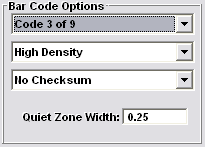Bar Code
When Bar Code is selected the area to the right changes to Bar Code Options. In this area are two pull-down areas that allow selection of the bar code type and the density in which to display it. Beneath these pull-downs will appear various radio button controls to set the characteristics of the selected bar code.

The ID badge software provides a wide range of bar code types as listed below.
· Code 3 of 9
· Extended Code 3 of 9
· Interleaved 2 of 5
· Code 93
· Extended Code 93
· UPCA
· UPCE
· EAN 13
· EAN 8
· Code 128
· Codabar
· MSI Plessey
· POSTNET
Remember when choosing a bar code type that not all types can display all characters. For example, the Interleaved 2 of 5 bar code can only display numeric information so you must take care not to assign it to a data field which might contain non-numeric characters.
The density control will allow for wider or narrower bars as the density is decreased and increased, with high density allowing the most characters to be displayed in a given rectangle space.
Bar codes are drawn using TrueType fonts. It is possible to suppress the background rectangle and have bar codes displayed directly on the badge background. uncheck the Rectangle Color Background check box to control this feature.
Why are TrueType barcode fonts important? If you are planning to print badges with visible bar codes, it does not matter whether or not they are TrueType. But if you want to print an InfraRed (IR) bar code then the bars must be printed using a carbon-based ink. Printers with carbon-based black ribbons or panels vary in how they decide when to use them, as opposed to “creating” black by combining the 3 colors. (The color ribbons or panels are not carbon-based.) Experimentation will be needed to determine when your printer uses the carbon-based black ink. If you want to create a “hidden” bar code, try making the enclosing rectangle background color black. The background should be developed from the 3 colors and the bars from the carbon-based ink. As a result a visible reader will not be able to read it, but an IR reader will. Your printer may not be able to do this, so experimentation is in order.
NOTE
Printer drivers vary in the way
they handle TrueType fonts. Some automatically convert them to graphics,
so using TrueType font bar codes may have no
effect. Other drivers allow you to choose whether or not to convert
TrueType fonts to graphics. A switch in the driver configuration panel
will exist to select this feature. Of course, the conversion must be
switched off to be useful. Still other drivers print TrueType fonts when
the text is oriented horizontally, but convert them to graphics if the text is
rotated or inverted. You will need to experiment with your printer to see
how it handles TrueType fonts.
Finally, you will find a numeric entry box labeled “Quiet Zone Width”. This value defaults to 0.25” and ensures a “quiet” or white space at the beginning and end of the bar code. Some readers, particularly optical ones, require this quiet zone. Other readers, notably infra-red, may not need a quiet zone and this area can be reduced or eliminated, allowing more digits to be encoded. You will not be allowed to enter a quiet zone which is larger than half the longer axis of the rectangle. Of course, entering a quiet zone which is half the length of the longer axis would not leave much room for the bar code!